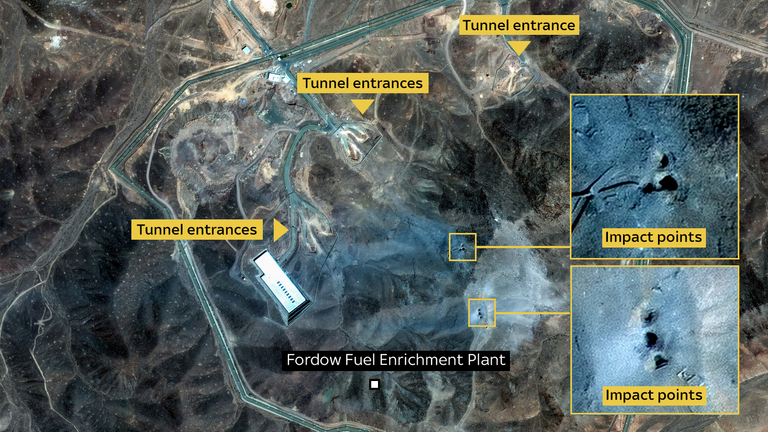Articles in this Cluster
24-06-2025
US airstrikes on 22 June targeted Iran’s key nuclear sites at Fordow, Natanz, and Isfahan, using 30,000‑lb GBU-57 bunker-buster bombs to reach deeply buried facilities. Satellite imagery indicates multiple impacts at Fordow, likely aimed at access tunnels and ventilation shafts to damage the underground centrifuge hall. Natanz and Isfahan, previously hit by Israel, were struck again, including against bunkered centrifuges and the uranium conversion plant. While the attacks likely caused serious damage to industrial-scale enrichment capacity and will set back timelines, Iran’s existing stockpile of highly enriched uranium and its dispersed expertise and smaller facilities mean the program is not eliminated. Experts caution that military strikes alone cannot fully dismantle Iran’s nuclear capabilities, and the impact on weaponisation intent remains unclear.
Entities: United States, Iran, Fordow, Natanz, Isfahan • Tone: analytical • Sentiment: neutral • Intent: analyze
24-06-2025
Experts warn Iran likely has additional underground sites that could be converted for uranium enrichment despite reported destruction of key facilities at Fordow, Natanz, and Isfahan. David Albright notes a previously identified underground complex near Natanz and suggests material may have been moved from Fordow before strikes, though he sees a low short-term risk of rapid restart due to disarray. Jeffrey Lewis and Emily Harding argue Iran may have dug multiple undeveloped underground sites to preserve options, potentially complying with the letter but not the spirit of IAEA obligations. Iranian nuclear chief Mohammad Eslami recently claimed a new “secure and invulnerable” enrichment site is ready for centrifuge installation, amid IAEA censure for lack of transparency.
Entities: Iran, International Atomic Energy Agency (IAEA), Fordow, Natanz, Isfahan • Tone: analytical • Sentiment: negative • Intent: warn
24-06-2025
Vice President JD Vance said he believes Iran’s stockpile of 60%-enriched uranium was “buried” under three nuclear facilities hit by U.S. bunker-buster strikes, aiming to halt enrichment capabilities. However, IAEA chief Rafael Grossi and other experts warn the material’s status is uncertain, citing satellite images of cargo trucks at Fordow before the strikes and Iranian claims of “special measures” to safeguard materials. Analysts suggest Iran may have moved, hidden, or even outsourced the uranium, though the risk of its use in a dirty bomb is considered low. The strikes, which included GBU-57 bombs, heavily damaged Fordow but left questions about the fate of roughly 400 kg of enriched uranium and Iran’s potential to covertly advance its nuclear program.
Entities: JD Vance, Iran, 60%-enriched uranium, IAEA, Rafael Grossi • Tone: analytical • Sentiment: neutral • Intent: inform
24-06-2025
The article reports that the U.S. used its 30,000-pound GBU-57 Massive Ordnance Penetrator—the most powerful U.S. conventional bunker-buster—in its first-ever combat deployment to strike Iran’s deeply buried Fordo uranium-enrichment facility. Joining Israel’s war against Iran, the U.S. dropped multiple GBU-57s as part of a large operation involving over 100 aircraft, aiming to neutralize a site believed to house thousands of centrifuges at depths up to 80–90 meters. While the bomb can penetrate about 60 meters and may require repeated precision hits to destroy such targets, the strike represents a major escalation and a unique U.S. capability Israel lacks. The attack carries limited radiological risk compared to hitting reactors but could have significant strategic consequences for Tehran’s nuclear program and the broader conflict.
Entities: GBU-57 Massive Ordnance Penetrator, Fordo uranium-enrichment facility, United States, Israel, Iran • Tone: urgent • Sentiment: negative • Intent: inform
